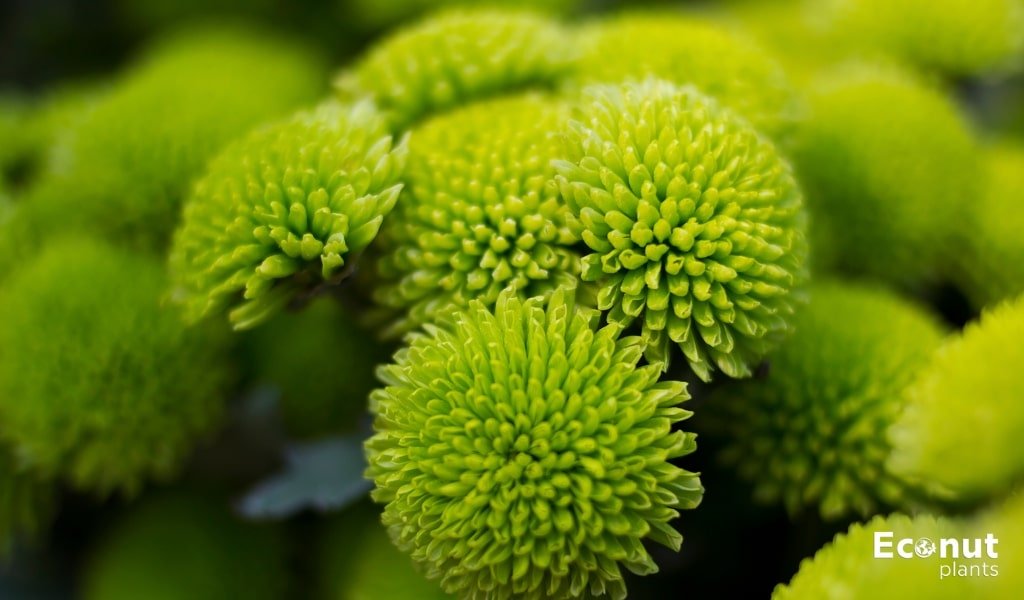Do you want to add some green flowers to your garden, but you’re not sure which ones would work best? While there are numerous varieties of green-blooming flowers, not all of them are suitable for every type of temperature or region.
This post features some of our favourite green-coloured flowers that look great in gardens in almost every hardiness zone.
1. Chrysanthemum
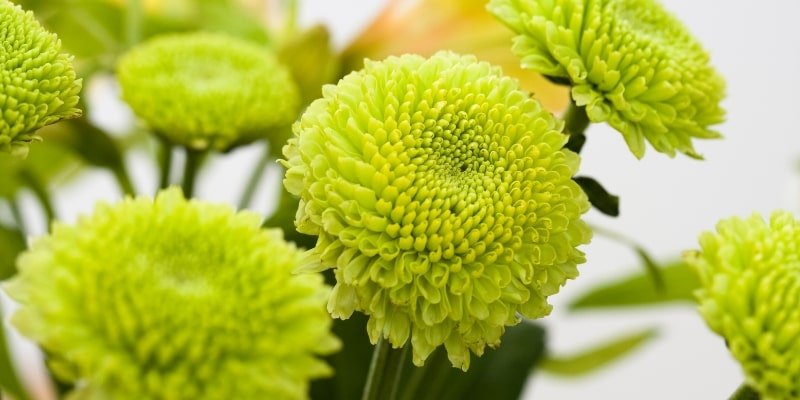
Scientific Name: Chrysanthemum
Chrysanthemum is a genus of flowering plants that is mostly native to eastern Asia and belongs to the Asteraceae family of plants. But certain species are also seen growing naturally in parts of northeastern Europe.
There is a great range of shapes, sizes, textures, and colours in chrysanthemum blossoms. They bloom in a variety of shades of green, as well as nearly every other colour in the rainbow. Green chrysanthemums come in several well-liked kinds, such as “Anastasia Green,” “Green Mist,” “Feeling Green,” and “Green Trick.”
The button and spider kinds of green chrysanthemums are frequently used in floral arrangements designed by florists.
2. Sweet Pitcherplant
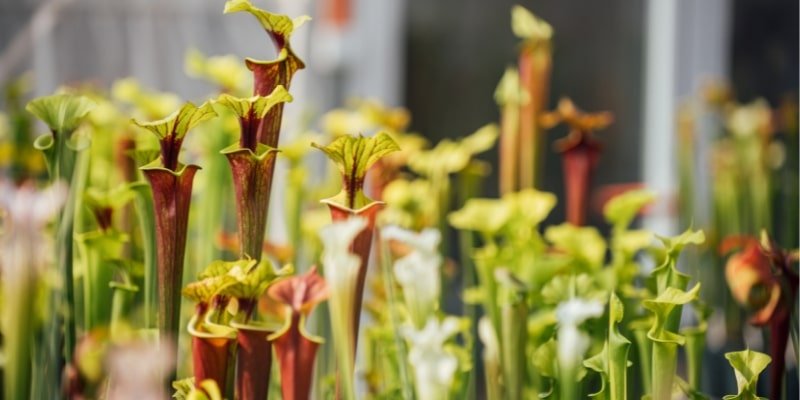
Scientific Name: Sarracenia rubra
Sarracenia rubra is a carnivorous plant that is indigenous to the Southeast of the United States and is a part of the Sarraceniaceae family. Insects can get trapped in the tube-shaped, coiled leaves of sweet pitcher plants, creating “pitchers” that the plant can then consume.
In addition to being a deep shade of purple, these tubes are frequently green in colour. In the spring, they also yield vibrant crimson blooms. Prey and pollinators are attracted to the pitchers and blooms of sweet pitcher plants because of their delightful scent.
3. Papyrus
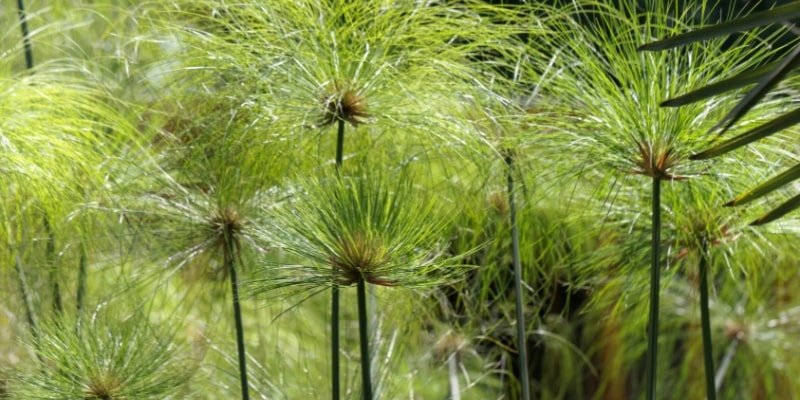
Scientific Name: Cyperus papyrus
Cyperus papyrus, often known as paper reed, papyrus, or Nile grass, is an herbaceous perennial plant native to Africa that is a member of the sedge family of plants, Cyperaceous. This plant thrives in marshy, damp places. With poms of green leaves emerging from the tops of their stems, they resemble reeds in appearance.
These particular plants are uncommon in gardens around the world, but they are most famous for their use in ancient Egypt, where they were gathered and turned into papyrus, which was one of the earliest forms of paper ever made.
4. Common Hop
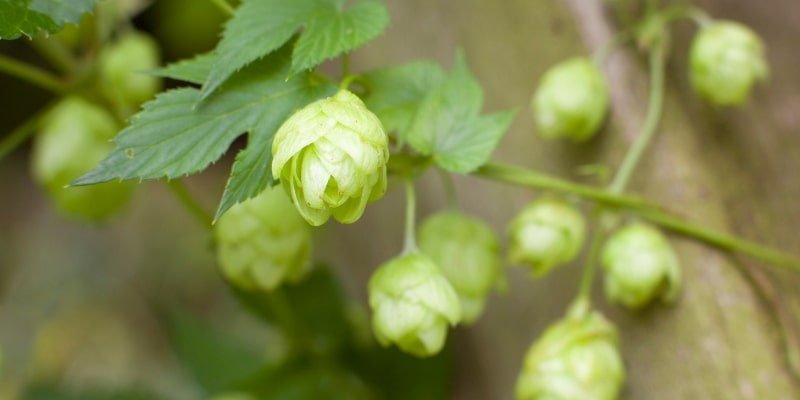
Scientific Name: Humulus lupulus ‘Cascade’
The plant species known as Humulus lupulus “Cascade” is most recognized for its use in beer manufacturing as a flavouring ingredient. Native to North America, Europe, and Western Asia, common hops is a perennial herbaceous flowering plant in the Cannabaceae (hemp) plant family.
The plants are climbers that yield cone-shaped, light-green blooms (at least on the female plants) and deeply lobed leaves. These delicately scented blossoms are the main component used in brewing.
5. Mediterranean Spurge
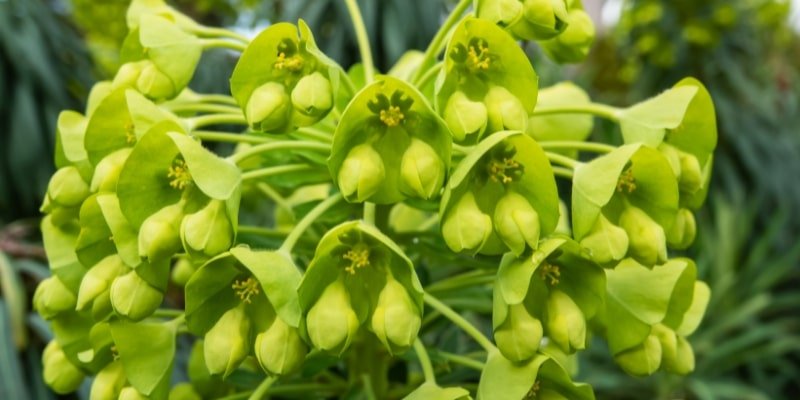
Scientific Name: Euphorbia characias
Euphorbia characias is an evergreen shrub with flowers that is a member of the Euphorbiaceae family of plants. This species of spurge is indigenous to the Mediterranean region, as its common name implies. The plant yields woolly-textured, compact, upright stems.
The leaves have a blue-green or silvery-dusty colour. Chartreuse blossoms are arranged in huge, cloud-like, globulous, or slightly balloon-shaped clusters in flower varieties grown in gardens. These variations are colourful, spectacular, and elaborate.
6. Sweet William
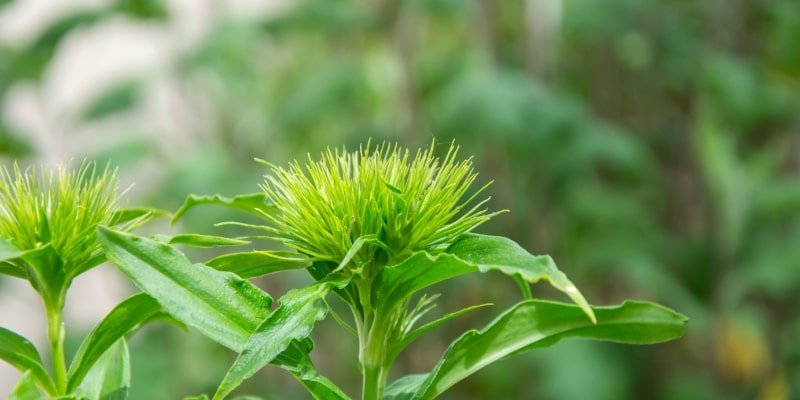
Scientific Name: Dianthus barbatus ‘Green Ball’
A genus of flowering plants endemic to Europe, Asia, and Africa is called Dianthus. The genus includes flowers that are often referred to as Sweet William, pink, and carnations. The Dianthus barbatus cultivar known as “Green Ball” has an odd appearance due to its many ruffled petals, which give the flower head a fuzzy, pom-pom-like appearance.
The blossoms open out into a vivid shade of lime green that is quite attractive in any garden or bouquet, in addition to their unusual texture.
7. Tulip
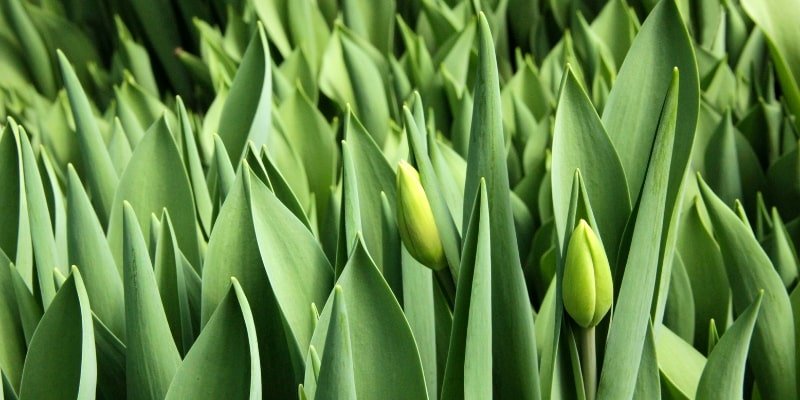
Scientific Name: Tulipa viridiflora
The genus Tulipa comprises blooming plants that are part of the Liliaceae, or family of lilies. Tulips are among the most well-liked and extensively grown plants in the world, possibly only surpassed by roses.
While there are many green variants, some of the most well-known are the green forms of Tulipa viridiflora, which have green stripes running the length of the petals in addition to the stems. Certain cultivars of this plant have petals that are all green, while others have petals that are coloured differently with a noticeable green stripe running down the middle.
8. Green Flutter Daylily
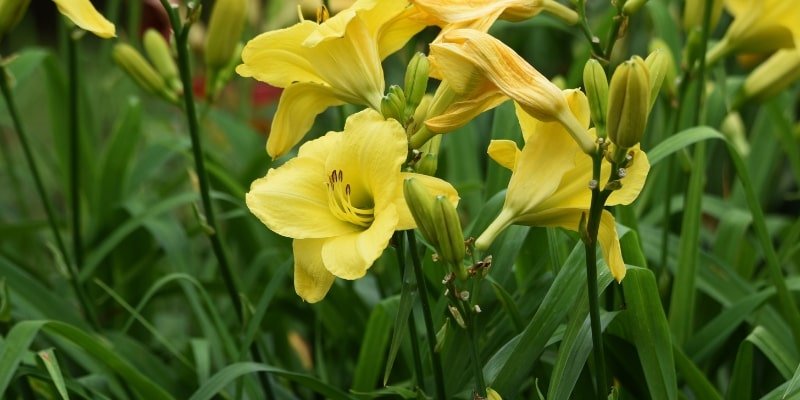
Scientific Name: Hemerocallis ‘Green Flutter’
Hemerocallis is a genus of sixteen flowering plants in the Asphodelaceae family of plants that are native to Asia. These plants, also known as daylilies, bear leaves resembling lances and star-shaped blooms that closely mimic the structure of real lilies, but they are not lilies.
One common green-coloured variant is called “green flutter daylilies.” When fully grown, they reach a height of roughly 20 inches and have lovely lime-green flowers with noticeable, matching stamens. Furthermore, they bloom twice a year, in early autumn and late summer.
9. Venus Slipper Orchid
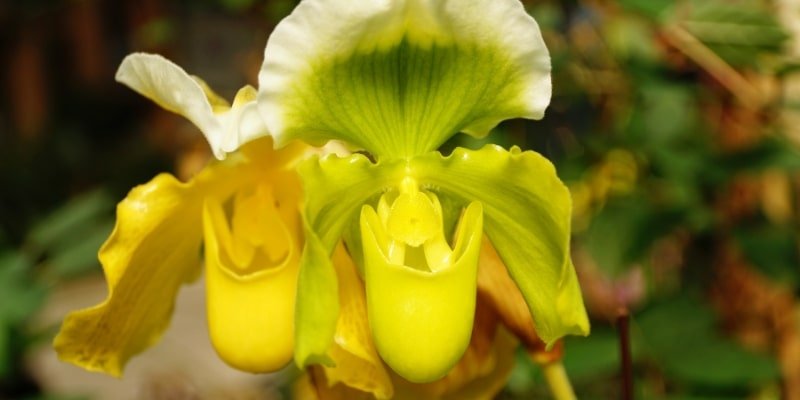
Scientific Name: Paphiopedilum primulinum
Paphiopedilum primulinum is a species of orchid native to Sumatra that is a member of the Orchidaceae (orchid) plant family’s Cypripedioideae (lady slipper) subfamily. Venus slippers are the popular name for these flowers.
These orchids are named for the flower blossoms that they have a brilliant lemon-lime tint for, and their flowers have the same distinctive slipper-shaped labellum.
10. Flat-Leaved Vanilla
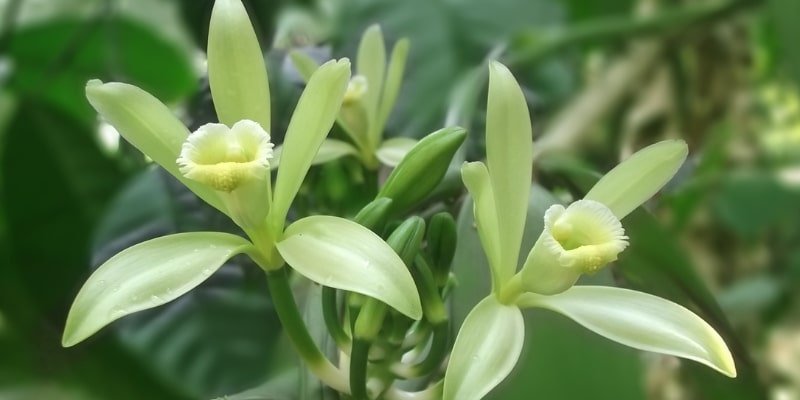
Scientific Name: Vanilla planifolia
A species of flowering vine in the Orchidaceae family of plants is called Vanilla planifolia. It is indigenous to Mexico and Belize. The vine yields lovely pendulous flowers that bloom in shades of yellowish-green as well as waxy, ovate, vibrant-green leaves.
Pollinators, however, only have a brief window of opportunity to pollinate because the flowers only endure for a single day. For this reason, most cultivated plants are pollinated by human hands. It is one of the main sources of vanilla flavouring due to its high vanillin content. The plant is considered endangered because of its widespread use and popularity—or maybe because of these factors.
11. Cymbidium Orchid
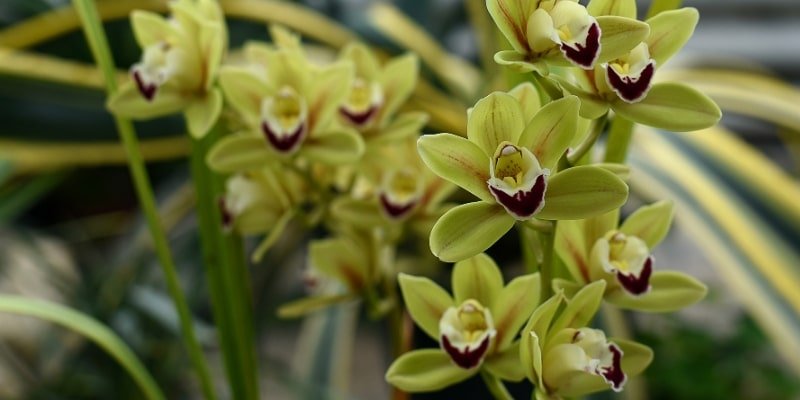
Scientific Name: Cymbidium
Many garden centers and flower stores carry Cymbidium orchids, which are among the most popular varieties.
The genus Cymbidium belongs to the Orchidaceae, or orchid, family of plants. Numerous exotic flower varieties in the genus include green blossoms with hues ranging from apple green to chartreuse. Cymbidium chloranthum is one of the species of green Cymbidium orchids.
12. Flowering Tobacco

Scientific Name: Nicotiana alata
Nicotiana alata is a type of flowering plant native to Iran that is a member of the Solanaceae (nightshade) plant family. The plants have tubular, thin flowers that open up into brilliant star forms at the ends and ovate leaves.
There are numerous cultivars and variations of this plant. Though some cultivars feature pink, magenta, yellow, or green flowers, they naturally bloom white. Some plants even have many hues of bloom. The blossoms also release a pleasant aroma that is especially intense in the evening and at night. They are delightfully fragrant.
13. Green Jewel Coneflower
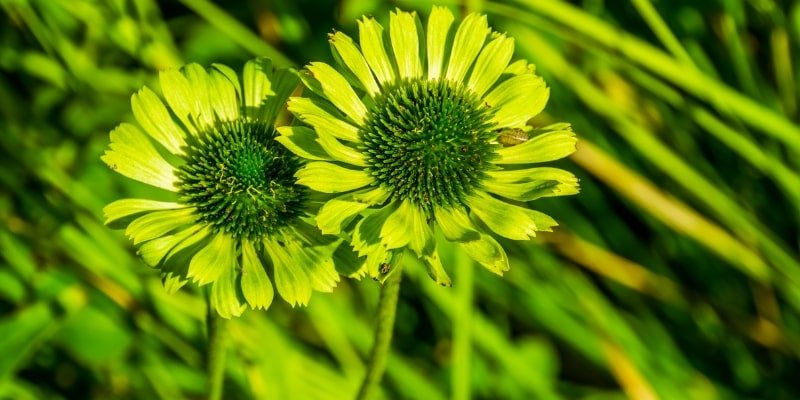
Scientific Name: Echinacea purpurea ‘Green Jewel’
Similar to the coconut lime coneflower, the green gem coneflower belongs to the Asteraceae plant family and is a cultivar of the eastern purple coneflower (Echinacea purpurea).
But this variety has a richer shade of green, with lemon-lime petals and a noticeable apple-green center cone. Furthermore, instead of the typical downturned petals that most coneflowers have, this cultivar has slightly upturned petals that give it a more daisy-like appearance.
14. Wild Garlic

Scientific Name: Allium ursinum
Allium ursinum is a bulbous perennial plant that belongs to the Amaryllidaceae family and is native to Asia and Europe. It produces clusters of greenish-white blooms and vivid green leaves. The plant’s edible roots, which belong to the Allium genus and include garlic and onions, are what make it most famous.
The plant is also known by the common names bear’s garlic and bear leek. The scientific name ursinum, which comes from the Latin word for bear, is referred to by these names. These plants grow in their wooded surroundings, and it is said that brown bears have a fondness for their scented roots.
15. Bells of Ireland
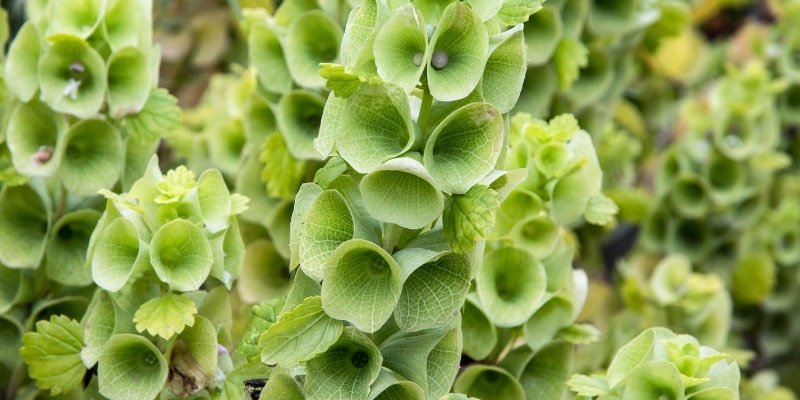
Scientific Name: Moluccella laevis
Moluccella laevis is a flowering plant species that is native to Turkey, Syria, and the Caucasus. It is a member of the Lamiaceae (mint) plant family. Apart from the popular name bells of Ireland, another common name for this plant is shellflower.
The plants are tall and thin, growing to a height of almost three and a half feet, and they have a branching growth habit. They generate tiny white blooms all over the stems when they are in bloom. Large calyces, or cup-shaped sepals that resemble green bells, envelop these flowers. Good luck is symbolized by bells of Ireland flowers in the Victorian Language of Flowers.
16. Coconut Lime Coneflower
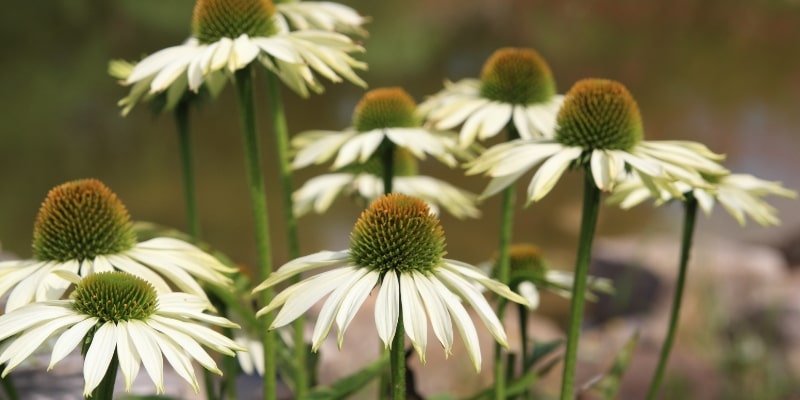
Scientific Name: Echinacea purpurea
The coconut lime coneflower, a member of the Asteraceae plant family, is a cultivar of Echinacea purpurea, also known as the eastern purple coneflower because it normally blooms in its native location in eastern North America with vivid purple petals and a brownish orange central cone.
On the other hand, the coconut lime variant has petals and a center cone that has the hue of lime juice mixed with coconut milk. Additionally, the shape of the central cone is considerably more pronounced, resembling a circular, green coconut.
17. Italian Arum
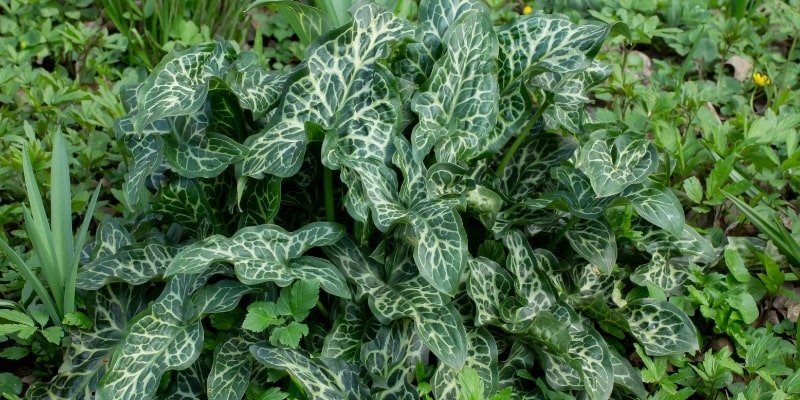
Scientific Name: Arum italicum
The Italian arum is a native of the Mediterranean region and a member of the Araceae plant family. This plant is a member of the genus Arum. The Italian arum shares characteristics with its cousins, which are flowers like calla and peace lilies, including greenish, milky-white spathes with yellowish spadixes that serve as the most striking elements of the blooming.
The Italian arum, on the other hand, has huge, variegated leaves that stay rather low to the ground, unlike its cousins. The flowers appear to be nearly half-sunk in the ground since they are comparatively huge and emerge straight from the middle of the foliage.
18. Hydrangea
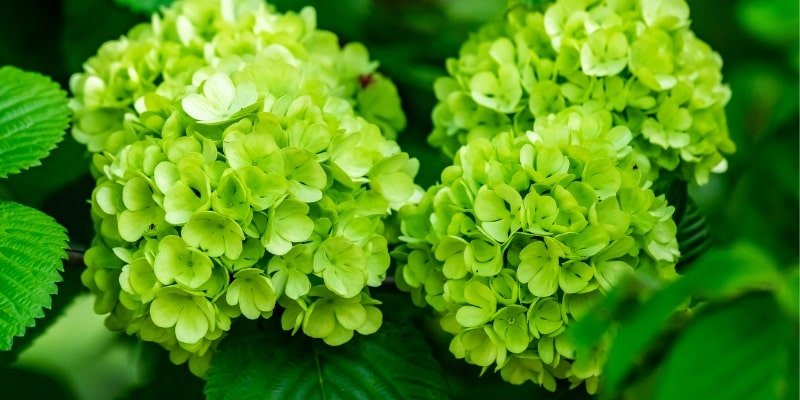
Scientific Name: Hydrangea
Hydrangea is a genus of blooming trees, shrubs, and lianas native to Asia and the Americas that are a part of the Hydrangeaceae plant family. Garden favourites all around the world, hydrangeas are prized for their spectacular clusters of bulbous flowers.
Pale pink, purple, blue, and white sepals are predominant in these flower clusters. The sepals are green, despite these hues. Certain kinds of hydrangea flowers might frequently appear completely green, depending on the soil composition in which the plant is grown and the time of the hydrangea growing season.
19. Green Rose
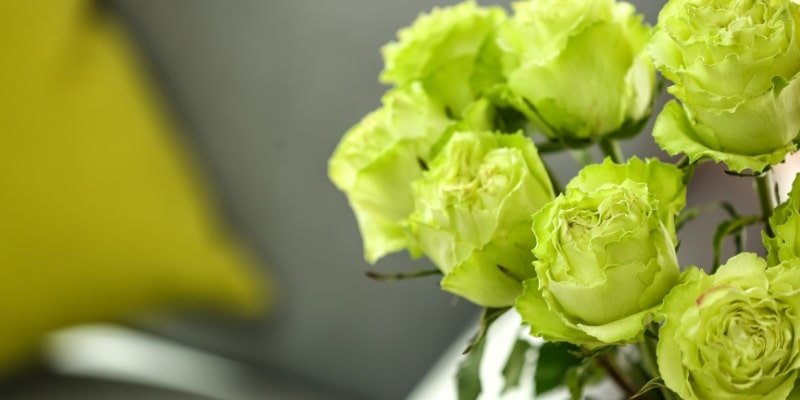
Scientific Name: Rosa chinensis ‘Viridiflora’
As with all other roses, Rosa chinensis ‘Viridiflora,’ also known as the green rose, belongs to the Rosaceae family of plants; nonetheless, its vibrant bloom is unforgettable. Green rose buds are identical to each other in appearance.
Nevertheless, no petals are visible when they open up. Rather, all that makes up these blossoms are green sepals layered upon green sepals. (The pointed, leafy elements of a rose flower known as sepals are what close the bud and hold the petals in place from below as the bloom opens.) The outcome is a rose that is completely leafy-green in colour.
20. Love-Lies-Bleeding
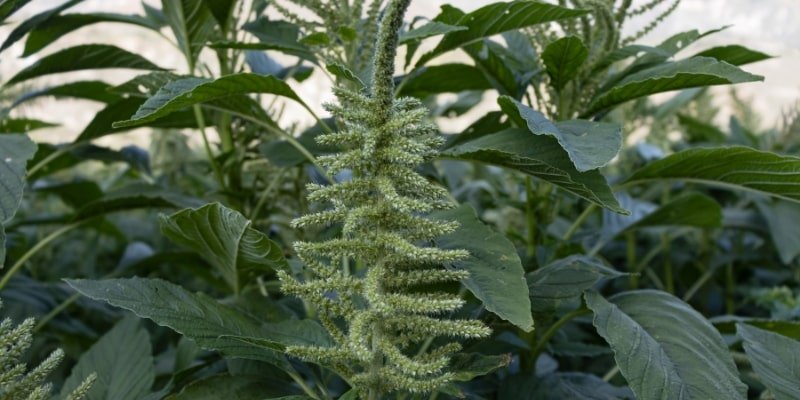
Scientific Name: Amaranthus caudatus
Amaranthus caudatus is a species of flowering plant that belongs to the Amaranthaceae (amaranth) plant family and is native to Africa, Peru, and India. It can grow to several feet tall and produce big, long clusters of finger-shaped flowers.
These blooms dangle in an almost grapevine-like fashion. These blooms’ seeds and leaves are both edible, and they’re a common food source in many parts of the world. Love-lies-bleeding, velvet flower, tassel flower, and pendant amaranth are some of its common names.
Love-lies-bleeding cultivars are available with vivid yellow-green blooms, including Amaranthus caudatus ‘Green Tails; however, the species usually produces dramatic reddish-magenta blossoms.
21. Polyanthus Primrose
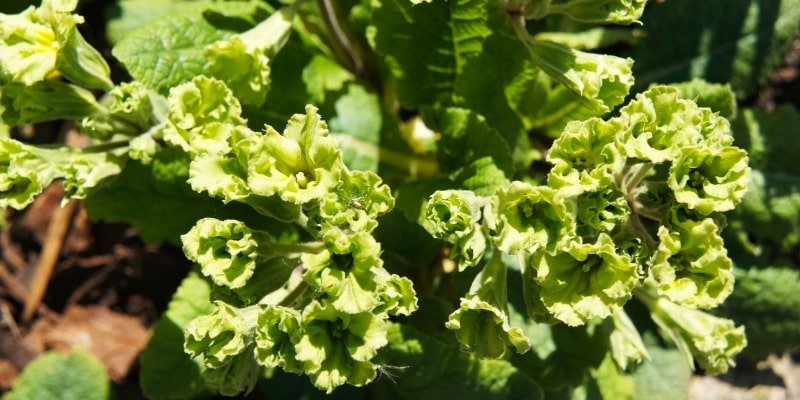
Scientific Name: Primula ‘Francisca’
Primroses, or Primulaceae, are a family of flowering plants that include more than 500 species, including the polyanthus primrose. The genus Primula contains these plants. From the northern to the southern hemispheres, primroses have a wide native range.
On the other hand, the Himalayas are home to the highest density of native species. Although every primrose is lovely with its little flower clusters and soft, ruffled leaf rosettes, the polyanthus primrose stands out due to its light-green flower clusters.
22. Dahlia
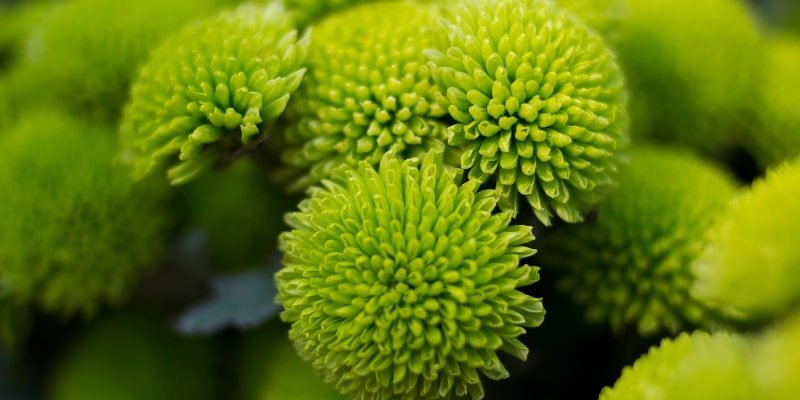
Scientific Name: Dahlia
Dahlia is a genus of 42 species (and many varieties) of bushy, blooming, herbaceous, perennial plants that are native to Central America and Mexico. They are members of the Asteraceae plant family. Dahlia plants yield a variety of flower heads.
The most well-liked are quite elaborate. These dahlia flowers are highly symmetrical and feature rows upon rows of spiraling pointed petals. They have an enthralling aspect that almost looks like a complicated mandala picture. Thanks to their huge, beautiful blossoms that appear in almost any colour you can imagine, including varied greens, dahlias are often cultivated in gardens.
23. Chinese Snowball
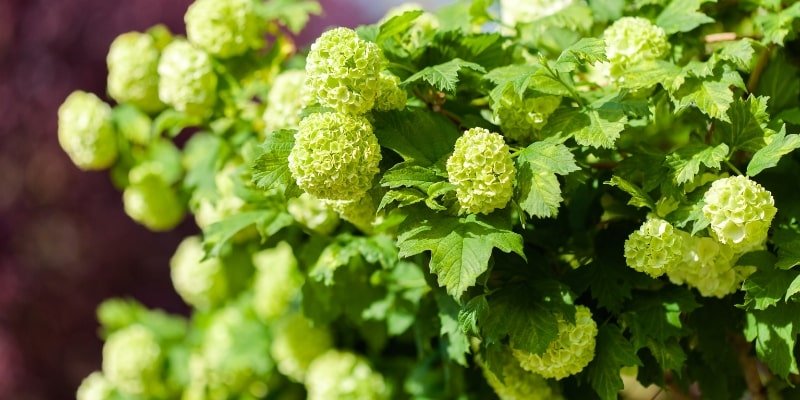
Scientific Name: Viburnum macrocephalum
A deciduous shrub with flowers, Viburnum macrocephalum can reach heights and widths of six to ten feet. It is a member of the Adoxaceae family of plants and is native to mainland China.
Known by most as a Chinese snowball, this plant bears huge, bulbous clusters of white or whitish-green blooms that resemble snowballs, as well as ovate, dark green leaves that are five to eight inches in diameter. In April, the plants flower.
24. Carnation
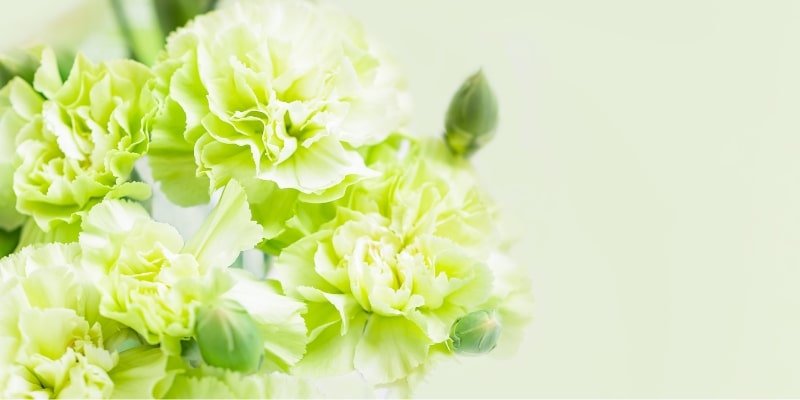
Scientific Name: Dianthus caryophyllus
A species of flowering plant native to the Mediterranean is called Dianthus caryophyllus. The Caryophyllaceae (pink) plant family includes this well-known flower. All the colours of the rainbow, except blue, are naturally seen as incarnations.
Popular green variants include ‘Green Trick’ among others. Despite going out of style a little, carnations are still stunning and are frequently used in floral arrangements by florists under the scientific name dianthus.
25. Cockscomb
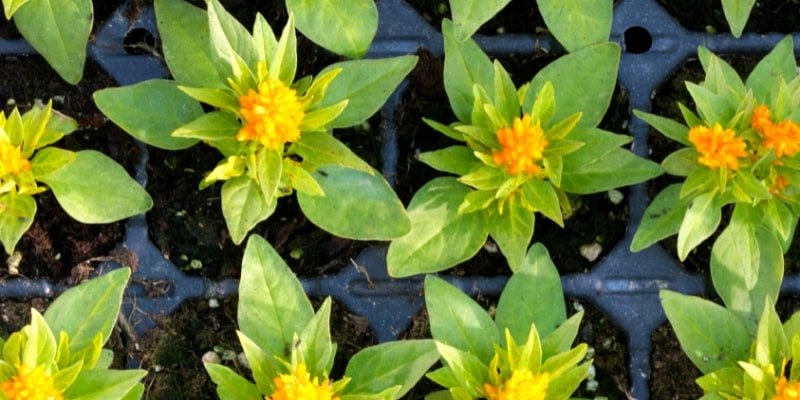
Scientific Name: Celosia
The Amaranthaceae family of plants includes the genus Celosia. Experts contest the theory that they originated naturally in Africa. Yellow, magenta, crimson, and orange hues are typical for their blossoms. On the other hand, Celosia cristata ‘Spring Green’ and Celosia plumosa ‘Sunday Green’ are two well-liked cockscomb variants with green-coloured blossoms.
First, there are flattened umbel-shaped flower blossoms; second, there are cone-shaped blooms. Though several varieties of cockscomb flowers are also frequently consumed as vegetables in some regions of the world, their ornamental value is what makes them so popular.
26. Conbush
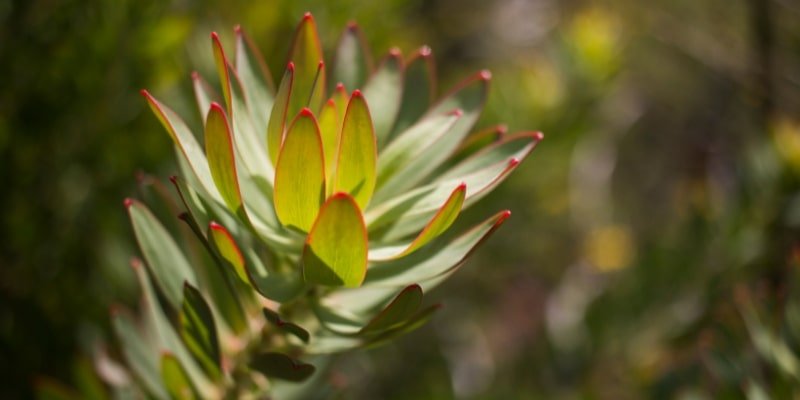
Scientific Name: Leucadendron
This genus of trees and shrubs, native to South Africa, is part of the Proteaceae family of plants and includes roughly eighty species. Along with the Leucadendron discolour species of cone bush, which naturally produces yellowish-green flowers, several other varieties of cone bush also provide green flowers.
All other species and varieties of these plants yield flaming red or yellow flowers, so these green beauties are the anomaly.
27. Wild Celery
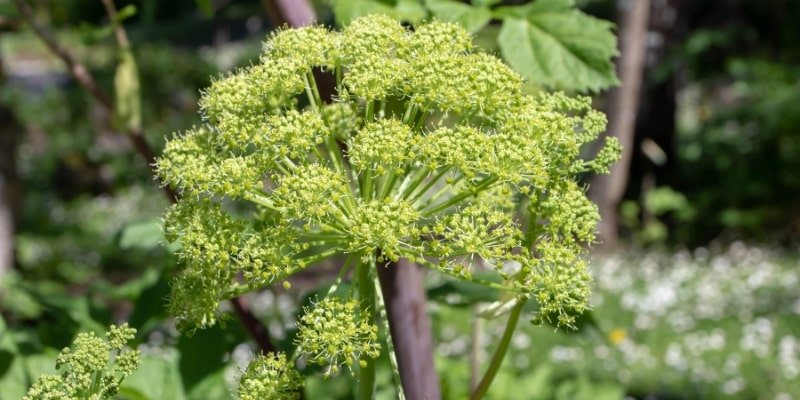
Scientific Name: Angelica
The term “wild celery” describes a group of plants of the Apiaceae (also known as parsley, carrot, and celery) family. The Angelica genus has over sixty herbaceous perennial and biennial species.
Because of the umbel-shaped inflorescences that members of this family produce, this family is sometimes known as the Umbelliferae plant family. On top of brown stems, wild celery bears clusters of lime-green blooms. The plants are indigenous to Greenland, Iceland, and Lapland, three subarctic regions of the Northern Hemisphere.
28. Corsican Lenten Rose
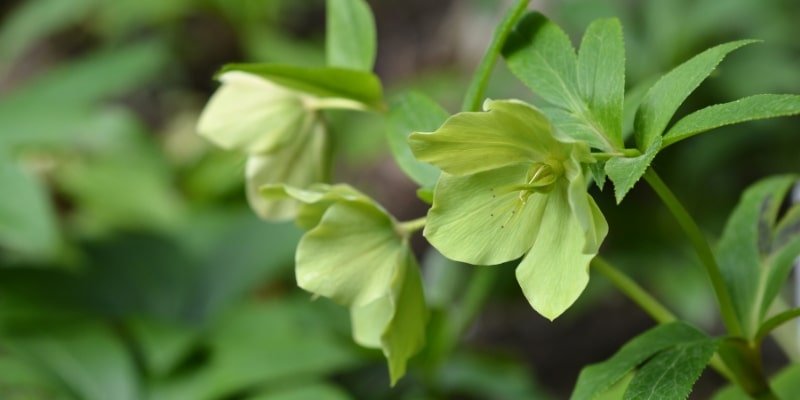
Scientific Name: Helleborus argutifolius
The Corsican Lenten rose is a member of the Ranunculaceae plant family and is an evergreen perennial with a bluish-green, finely serrated leaf. From late winter, during Lent, through summer, the star-shaped blossoms of pale greenish-white colour bloom.
They nod softly. These flowers, as their common name implies, are indigenous to Corsica. In Sardinia, they also grow naturally. Corsican hellebore and holly-leaved hellebore are two other common names.
29. Evergreen Amaryllis

Scientific Name: Hippeastrum ‘Evergreen’
The majority of people are already aware of the popular ornament and gift option of the forced, ruby-red amaryllis blossoms that bloom during the holiday season. The evergreen amaryllis, native to South Africa, offers a lime-green variety of the same flower.
This plant has sturdy, vibrant green stalks that contrast with its spidery, lily-shaped flowers. Despite their lily-like appearance, plants in the Hippeastrum flower genus belong to the Amaryllidaceae family, not the Liliaceae family.
30. Lady’s Mantle
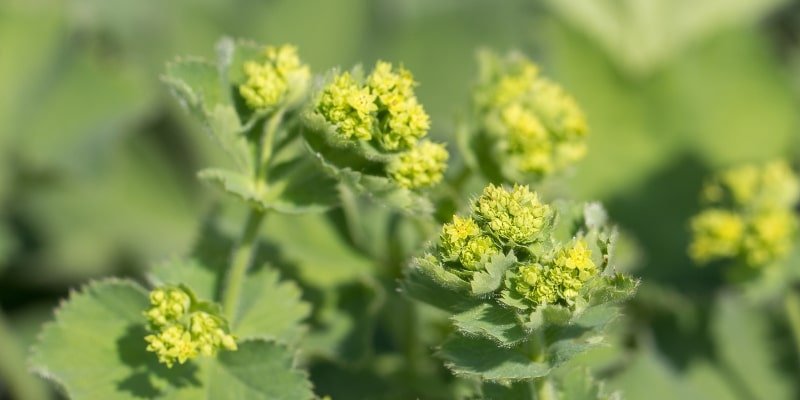
Scientific Name: Alchemilla mollis
A well-liked garden plant, lady’s mantle is grown for its lovely scalloped leaves and the little chartreuse flowers that bloom above the dark-green foliage. Originating from southern Europe, the plant possesses an intriguing past. Because of the natural dewetting characteristics of the plant’s leaves, moisture condenses into water beads.
It is said that alchemists used this water, believing it to be the purest on the planet, in their quest to transform different metals into gold. This is where the name Alchemilla comes from in the plant genus.
31. Gladiolus
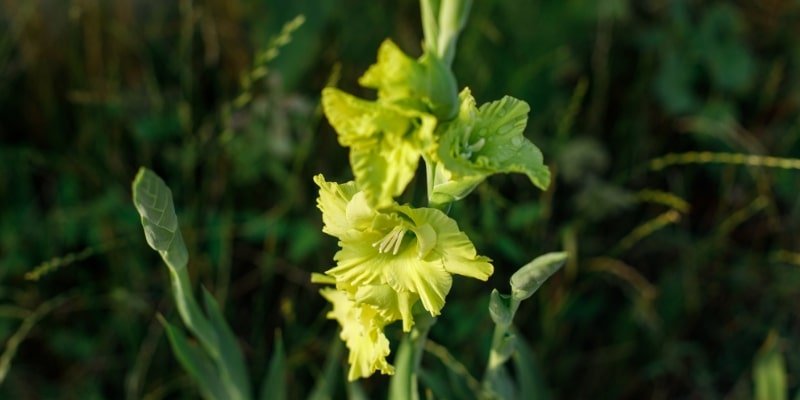
Scientific Name: Gladiolus
The genus Gladiolus is a member of the iris (Iridaceae) family of plants. These plants are most frequently known by their genus name, but because of the intricate racemes of blooms on them that resemble swords, they are also occasionally called sword lilies.
The majority of Gladioli species are indigenous to South Africa. Certain species, meanwhile, can also be found in the Mediterranean and other tropical regions of Africa in their native habitat. Gladiolus “Green Star” and Gladiolus “Green Flash” are two gladiolus cultivators that yield striking racemes of extraordinarily vividly coloured green blooms.
32. Smooth Solomon’s Seal

Scientific Name: Polygonatum biflorum
Smooth Solomon’s seal, a flowering shrub-like plant that is native to eastern and central North America, is a member of the Asparagaceae (Asparagus) plant family. It produces pendulous, bell-shaped blooms that are greenish-white in colour along slender stalks, as well as alternate, glossy green leaves.
There are little blue berries on Smooth Solomon’s seal as well. The common name for the plant originates from a legend that claims the marks on its roots mimic the seal of the ancient Hebrew monarch Solomon.
33. Green Hellebore
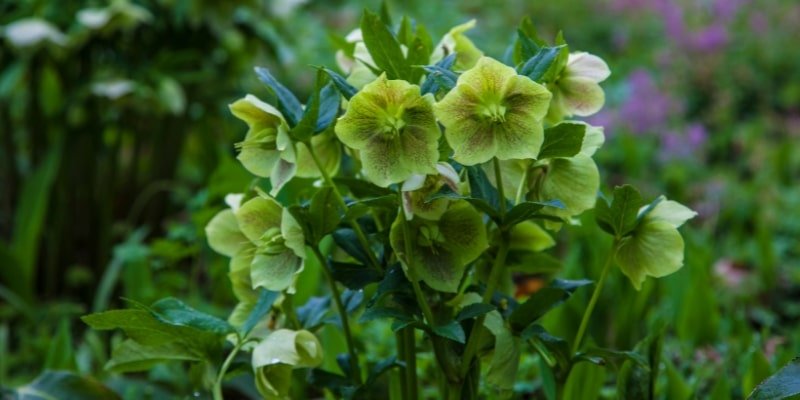
Scientific Name: Helleborus viridis
The flowering plant species Helleborus viridis is native to central and Western Europe and is a member of the Ranunculaceae (Ranunculus) family of plants. The plants feature an oval, bright green rosette of leaves in the center.
The plant grows tall (about 24 inches) branches from the center of this rosette, from which slightly pendulous blooms emerge. With lush sepals and a little center puff of paler lemon-lime petals, the blooms are nearly the same shade of green as the leaves.
34. Green Goddess Calla Lily
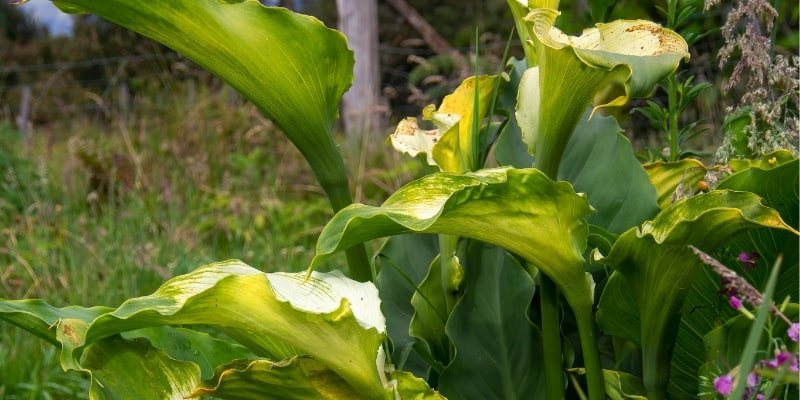
Scientific Name: Zantedeschia aethiopica ‘Green Goddess’
Native to southern Africa, Zantedeschia aethiopica, sometimes known as the calla lily, is a species of flowering plant. It belongs to the Araceae family of plants. Elegant flowers are the reason calla lilies are so popular. Every blossom has a long spathe that resembles a flared tube with a finger-shaped spadix in the center.
Typically, the spathes are white or whitish-yellow. On the other hand, the blossom of the green goddess calla lily varies in colour from a greenish-white at the base to a deeper shade at the tips of its vivid green leaves. The dazzling white and green hues of this blossom stem all resemble a bunch of fresh spring onions.
35. Zinnia
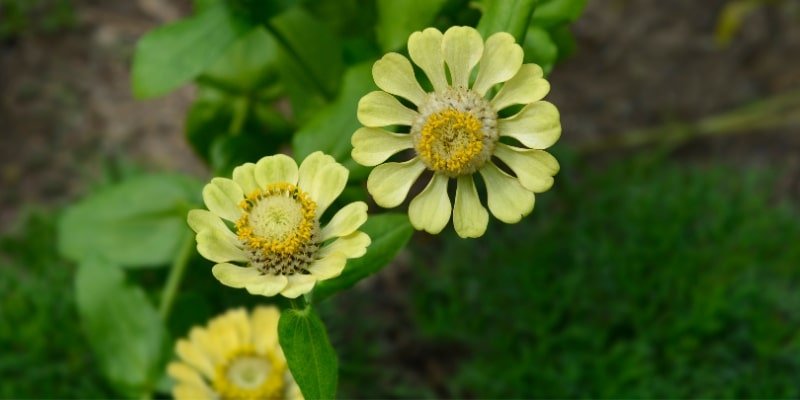
Scientific Name: Zinnia
Zinnias are a genus of blooming plants in the Asteraceae family of plants. Although a substantial portion of its native range, which stretches from South America to the southwest of the United States, is centered in Mexico, Zinnia blossoms are available in several types.
While some are big and showy with several layers of petals and vivid, variegated colours, others have single rows of petals. Their solitary blossoms are available in a variety of colours, including several shades of green. Gardeners’ favourite green zinnias are “Envy,” “Queen Lime Blush,” and “Giant Lime.”
Conclusion
We hope that this guide to 35 green flowers has provided you with the knowledge you need to start adding these amazing blooms to your garden. Take pleasure in their gorgeous green colours and allow them to astonish you! Cutting them is also a terrific way to introduce some foliage into your home.
As usual, please leave a comment below if you have any queries or if there is a bloom that we overlooked. Tell us about your favourite green flower as well!

